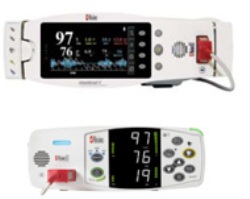Masimo (NASDAQ: MASI) and Alameda County Medical Center (ACMC) announced today the successful installation of Masimo Patient SafetyNet™ with rainbow® Acoustic Monitoring™ – advanced noninvasive technologies that help clinicians to save lives while helping hospitals to reduce costs.1
 Masimo rainbow SET
Masimo rainbow SET
ACMC, a nationally recognized public healthcare system with more than 2,800 employees, 500 physicians, and 475 beds, is among a growing number of healthcare systems to standardize on Masimo SET® and the Masimo rainbow® SET® technology platform, including Patient SafetyNet, and rainbow® Acoustic Monitoring.
Patient SafetyNet tracks the underlying physiological conditions of patients, and detects changes and abnormalities that signal declining health status in real time. When a patient's condition deteriorates, the system automatically sends wireless alerts directly to clinicians – prompting a potentially lifesaving response to the patient's bedside.
rainbow® Acoustic Monitoring noninvasively and continuously measures a patient's respiration rate using an innovative adhesive sensor with an integrated acoustic transducer that is easily and comfortably applied to the patient's neck. Acoustic Respiration Rate (RRa™) is a breakthrough measurement that facilitates earlier detection of respiratory compromise and patient distress – especially important for post-surgical patients receiving patient-controlled analgesia for pain management, as the sedation can induce respiratory depression and place patients at considerable risk of serious injury or death.2-4
"Masimo's Patient SafeyNet, coupled with Acoustic Monitoring, plays an important role in our efforts to provide the safest care possible to our patients after surgery," said Brandy Burrows, ACMC's Director of Respiratory Care Services. "Our goal is to provide the best care and Masimo's technology helps to safely meet recommendations from both the Joint Commission and the Anesthesia Patient Safety Foundation (APSF) to continuously monitor both oxygenation and ventilation of our post-surgical patients." 5
Alameda County Medical Center has also converted its pulse oximetry technology to Masimo SET®, which has been shown to virtually eliminate false alarms6 and increase a clinician's ability to detect life-threatening events.7 More than 100 independent clinical studies have confirmed that Masimo SET® technology allows clinicians to accurately monitor blood oxygen saturation in the most challenging conditions – helping to substantially contribute to improved patient outcomes. In addition, ACMC has also added Masimo rainbow® SET® Pulse CO-Oximetry capabilities—allowing clinicians to noninvasively monitor multiple blood constituents that previously required invasive or complicated procedures, including total hemoglobin (SpHb®), oxygen content (SpOC™), carboxyhemoglobin (SpCO®), methemoglobin (SpMet®), Pleth Variability Index (PVI®), and acoustic respiration rate (RRa).
Michael O'Reilly, MD, Chief Medical Officer of Masimo, stated: "Patients and their families can be confident that with the Masimo Patient SafetyNet system, they are being monitored at the bedside even when clinical staff is not in the room. We are honored that Alameda County Medical Center has selected Masimo technology to help protect their patients and improve patient outcomes."
(1) Taenzer A, Blike G, McGrath S, Pyke J, Herrick M, Renaud C, Morgan J. "Postoperative Monitoring – The Dartmouth Experience." Anesthesia Patient Safety Foundation Newsletter Spring-Summer 2012. Available online
(2) Joint Commission on Accreditation of Healthcare Organizations. Sentinel event alert: patient controlled analgesia by proxy; JCAHO. 2004.
(3) Institute for Safe Medication Practices. Safety issues with patient-controlled analgesia: Part I – How errors occur; ISMP. 2003.
(4) Bird M. Acute pain management: a new area of liability for anesthesiologists; ASA Newsletter. 2007; 71:8.
(5) Stoelting RK, Weinger MB. Dangers of Postoperative Opioids -- Is There a Cure? APSF Newsletter, 2009;24:25-26. http://www.apsf.org/newsletters/html/2009/summer/index.htm
(6) Shah N, Ragaswamy H, Govindugari K, Estanol L. "Performance of three new-generation pulse oximeters during motion and low perfusion in volunteers." Journal of Clinical Anesthesia. 2012 (10.1016/j.jclinane.2011.10.012) Available online here
(7) Taenzer, Andreas H.; Pyke, Joshua B.; McGrath, Susan P.; Blike, George T. "Impact of Pulse Oximetry Surveillance on Rescue Events and Intensive Care Unit Transfers: A Before-and-After Concurrence Study." Anesthesiology, February 2010, Vol. 112, Issue 2. Available online here